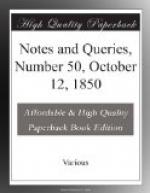REMAINS of ROMAN ART in Cirencester, the Site of Ancient Corinium; containing Plates by De la Motte, of the magnificent Tesselated Pavements discovered in August and September, 1849, with copies of the grand Heads of Ceres, Flora, and Pomona; reduced by the Talbotype from facsimile tracings of the original; together with various other plates and numerous wood engravings.
In the Quarto edition the folding of the plates necessary for the smaller volume is avoided.
“These heads (Ceres, Flora, and Pomona) are of a high order of art, and Mr. De la Motte, by means of the Talbotype, has so successfully reduced them that the engravings are perfect facsimiles of the originals. They are, perhaps, the best of the kind, every tessella apparently being represented.
“Our authors have very advantageously brought to their task a knowledge of geology and chemistry, and the important aid which an application of these sciences confers on archaeology, is strikingly shown in the chapter on the materials of the tessellae, which also includes a valuable report by Dr. VOELCKER, on an analysis of ruby glass, which formed part of the composition of one of the Cirencester pavements. This portion of the volume is too elaborate and circumstantial for any justice to be done to it in an extract.”—Gentleman’s Mag., Sept.
London: GEORGE BELL, 186. Fleet Street.
* * * * *
Printed by THOMAS CLARK SHAW, of No. 8. New Street Square, at No. 5. New Street Square, in the Parish of St. Bride in the City of London; and published by GEORGE BELL, of No. 186. Fleet Street, in the Parish of St. Dunstan in the West, in the City of London, Publisher, at No. 186. Fleet Street aforesaid.—Saturday, October 12. 1850.



